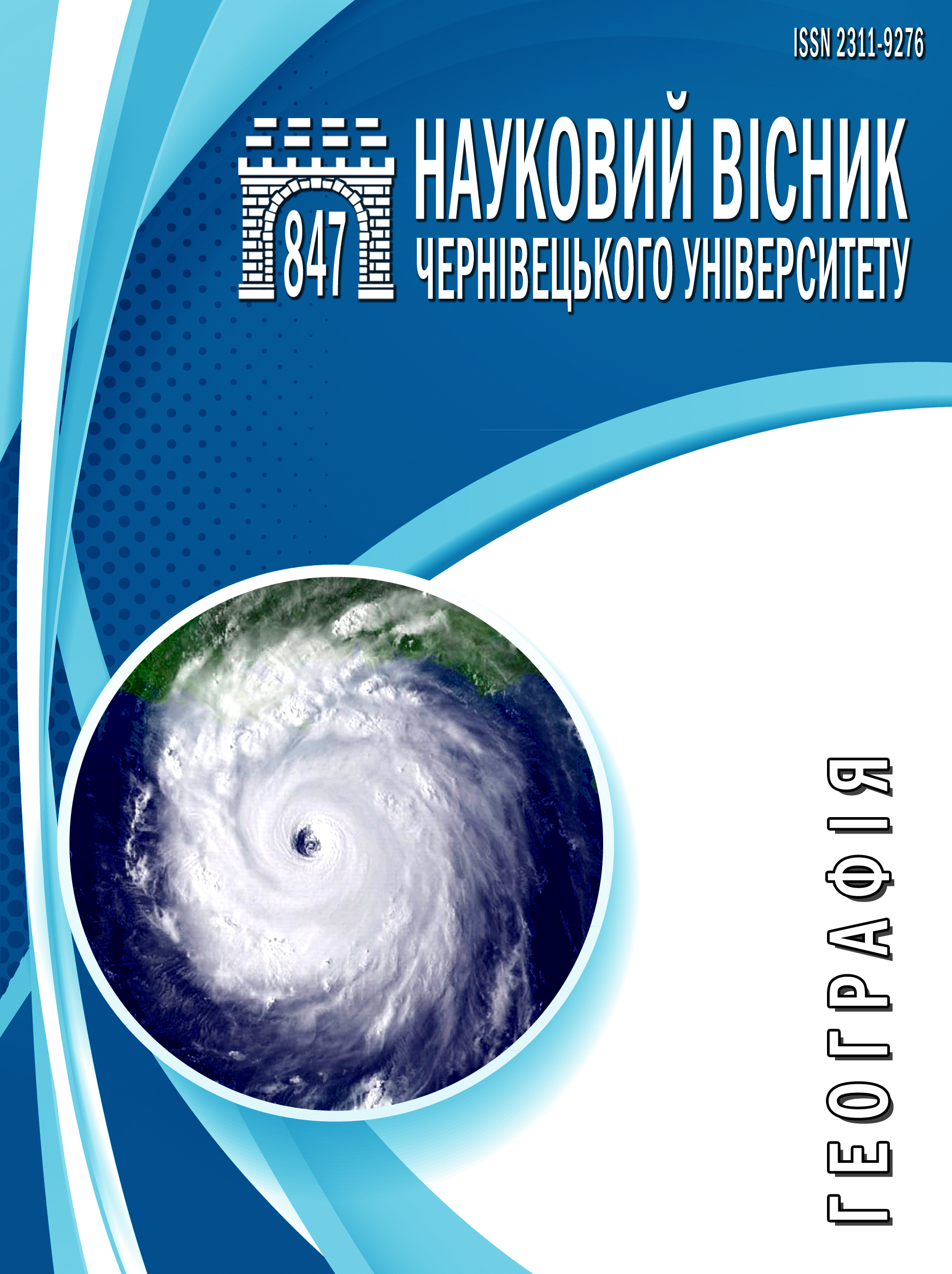Algorithm for assessing relief for fruit and berry farming (based on the example of the Khotyn Upland)
DOI:
https://doi.org/10.31861/geo.2024.847.192-203Keywords:
agriculture, Khotyn Upland, sustainable development, natural and economic variety, relief, rational nature useAbstract
Natural and geographical conditions, particularly the morphometric characteristics of the relief, significantly influence the effectiveness of cultivating perennial fruit and berry crops. Slope aspect, steepness, and elevation play a crucial role by determining microclimatic conditions, levels of solar radiation, soil drainage, and temperature regimes. Within the Khotyn Upland, a detailed cartographic and analytical study was conducted to identify optimal terrain conditions for horticulture, using morphometric parameters as the analytical foundation.
The developed assessment algorithm is based on three key relief characteristics. Slope aspect is classified into eight categories according to exposure to sunlight: from the south-facing slopes, which receive the highest solar radiation, to north-facing ones with the least exposure. Slope steepness is divided into five groups based on inclination (from gentle slopes of 0–5° to steep ones exceeding 20°). The hypsometric analysis includes eight elevation ranges – from low-lying areas to the highest elements of the region’s terrain (above 450 m).
The combination of these three parameters enabled the construction of a multi-variant suitability model comprising 320 unique categories of relief conditions. Each category is assigned a corresponding suitability score for fruit and berry cultivation. Spatial analysis revealed that the most favorable areas for orchard development are south-, southeast-, and southwest-facing slopes with moderate steepness (5–15°), situated within mid-elevation ranges (mainly up to 350 m above sea level). These areas stand out due to higher levels of solar exposure, optimal temperature regimes, and good drainage – creating favorable conditions for plant growth and fruiting.
The proposed algorithm is adaptable to local contexts and can be modified for other regions with different geomorphological features. Its implementation contributes to evidence-based planning of agricultural land use, enhances ecological balance in rural landscapes, and supports the formation of a spatially balanced model of sustainable land use within the Khotyn Upland.
References
1. Биксей, П. М. (1963). Овраги Хотинской возвышености и их классификация. Материалы ХІХ научной сессии, Тезисы докладов, Серия географических наук, 16-18. [Biksey, P. M. (1963). Ovragi Hotinskoy vozvyishenosti i ih klassifikatsiya. Materialyi XIX nauchnoy sessii, Tezisyi dokladov, Seriya geograficheskih nauk, 16-18.]
2. Бойко, Р. Д. (1970) Деякі особливості ерозійного рельєфу західної частини Прут-Дністровського межиріччя. Фізична географія та геоморфологія, (1), 83-86. [Boiko, R. D. (1970) Deiaki osoblyvosti eroziinoho reliefu zakhidnoi chastyny Prut-Dnistrovskoho mezhyrichchia. Fizychna heohrafiia ta heomorfolohiia, (1), 83-86.]
3. Горшенин, Н. М., & Швиденько, А. Й. (1977). Лесоводство. Львов: Вища школа. [Gorshenin, N. M., & Shvidenko, A. Y. (1977). Lesovodstvo. Lvov: Vischa shkola.]
4. Кирилюк, С. (2005). Геоморфологічні умови Хотинського району для цілей садівництва. Науковий вісник Чернівецького університету : Географія, (238), 105-121. [Kyryliuk, S. (2005). Heomorfolohichni umovy Khotynskoho raionu dlia tsilei sadivnytstva. Naukovyi visnyk Chernivetskoho universytetu : Heohrafiia, (238), 105-121.]
5. Кирилюк, С., & Гуцуляк, В. (2005). Оцінка рельєфних умов для вирощування плодових культур. Ландшафти та геоекологічні проблеми Дністровсько-Прутського регіону, Матеріали міжнародної наукової конференції, присвяченої 130-річчя заснування Чернівецького національного університету та 60-річчю створення кафедри фізичної географії, 151-152. [Kyryliuk, S., & Hutsuliak, V. (2005). Otsinka reliefnykh umov dlia vyroshchuvannia plodovykh kultur. Landshafty ta heoekolohichni problemy Dnistrovsko-Prutskoho rehionu, Materialy mizhnarodnoi naukovoi konferentsii, prysviachenoi 130-richchia zasnuvannia Chernivetskoho natsionalnoho universytetu ta 60-richchiu stvorennia kafedry fizychnoi heohrafii, 151-152.]
6. Симоновська, М. Я. (2004). Особливості дослідження ярів у басейні Дністра. Україна: географічні проблеми сталого розвитку, (2), 118-120. [Symonovska, M. Ya. (2004). Osoblyvosti doslidzhennia yariv u baseini Dnistra. Ukraina: heohrafichni problemy staloho rozvytku, (2), 118-120.]
7. Andresen, J. A., & Baule, W. J. (2020). Perennial systems (temperate fruit trees and grapes). Agroclimatology: Linking Agriculture to Climate, (60), 425-452. https://doi.org/10.2134/agronmonogr60.2016.0016
8. Musacchi, S., & Neri, D. (2019). Optimizing production of quality nursery plants for fruit tree cultivation. In Achieving sustainable cultivation of temperate zone tree fruits and berries (pp. 183-242). Burleigh Dodds Science Publishing.
9. Sherman, W. B., & Beckman, T. G. (2002). Climatic adaptation in fruit crops. In XXVI International Horticultural Congress: Genetics and Breeding of Tree Fruits and Nuts (pp. 411-428). https://doi.org/10.17660/ActaHortic.2003.622.43
10. Sousa, M. L., Gonçalves, M., Fialho, D., Ramos, A., Lopes, J. P., Oliveira, C. M., & De Melo-Abreu, J. P. (2022). Apple and pear model for optimal production and fruit grade in a changing environment. Horticulturae, 8(10), 873. https://doi.org/10.3390/horticulturae8100873
11. Strack, T., & Stoll, M. (2021). Implication of row orientation changes on fruit parameters of Vitis vinifera L. cv. Riesling in steep slope vineyards. Foods, 10(11), 2682. https://doi.org/10.3390/foods10112682
12. Wielgolaski, F. E. (2001). Phenological modifications in plants by various edaphic factors. International journal of Biometeorology, (45), 196-202. https://doi.org/10.1007/s004840100100
Published
Issue
Section
License
Copyright (c) 2024 Scientific Herald of Chernivtsi University : Geography

This work is licensed under a Creative Commons Attribution-NonCommercial-NoDerivatives 4.0 International License.


